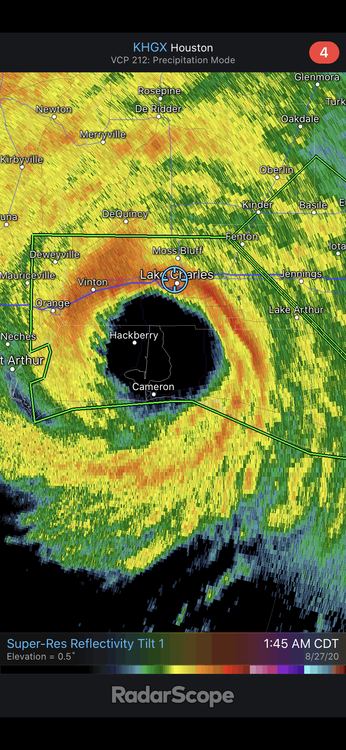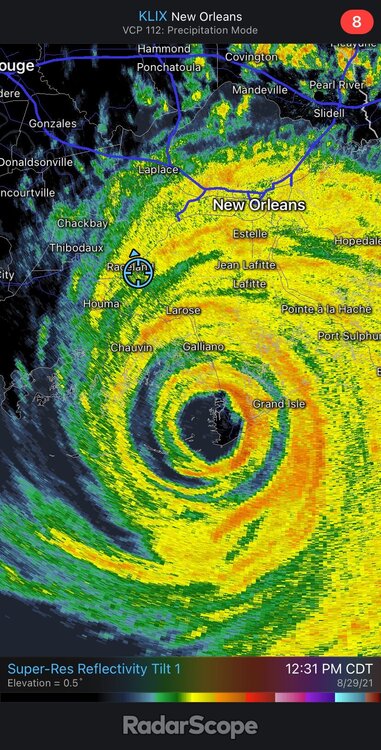-
Posts
1,166 -
Joined
-
Last visited
Content Type
Profiles
Blogs
Forums
American Weather
Media Demo
Store
Gallery
Everything posted by ncforecaster89
-

2021 Atlantic Hurricane season
ncforecaster89 replied to StormchaserChuck!'s topic in Tropical Headquarters
Very true, Amped! Not since the 1993 season has there been no TS or H formations after September 30. 1994 for last “October” without a NATL basin TC. I’d be very surprised if the season concludes without at least one additional TS. In contrast, I’ll be very surprised if the U.S. mainland experiences another hurricane landfall, however. -

2021 Atlantic Hurricane season
ncforecaster89 replied to StormchaserChuck!'s topic in Tropical Headquarters
Although 5 of the 6 U.S. hurricane landfalls were intensifying or steady-state at landfall…only two actually had well-defined eyewall structure (Hanna & Laura)…as you alluded to. Laura the best of those six: -

2021 Atlantic Hurricane season
ncforecaster89 replied to StormchaserChuck!'s topic in Tropical Headquarters
Personally, I’d rate them in the following order (2002-2021): (U.S. mainland only) 2005: (6 H strikes/4 MHs/Katrina) 2004: (6 H strikes/3 MHs/Charley) 2017: (3 H strikes/2 MHs/Harvey, Irma) 2020: (6 H strikes/3 MHs/Laura) 2018: (2 H strikes/1 MH/Michael) 2021: (2 H strikes/1 MH/Ida) 2008: (3 H strikes/0 MHs/Ike) 2012: (2 H strikes/0 MHs/Sandy) 2016: (2 H strikes/0 MHs/Matthew) 2003: (2 H strikes/0 MHs/Isabel) 2011: (1 H strike/0 MHs/Irene) 2014: (1 H strike/0 MHs/Arthur) 2002: (1 H strike/0 MHs/Lili) 2019: (2 H strikes/0 MHs/Dorian) 2007: (1 H strike/0 MHs/Humberto) 2006: (0 H strikes/0 MHs/Ernesto) 2010: (0 H strikes/0 MHs/Earl) 2015: (0 H strikes/0 MHs/Bill) 2009: (0 H strikes/0 MHs/Ida) 2013: (0 H strikes/0 MHs/Andrea) The list is naturally subjective. Speaking of subjective analysis, you’ll notice the inclusion of “Sally” as a MH (in the totals) for the 2020 season, as the data supports a 100 kt landfall intensity…in my personal opinion. It’s also important to note that “Ernesto” of 2006 may have actually achieved a 65 kt Cat 1 intensity, at landfall, as mentioned in its TCR. Also, H Earl of 2010 brought HF winds to the Outer Banks of NC even though it passed 90 nm offshore to the E. Gave 2015 the edge over the subsequent two seasons, shown on the aforementioned list, in deference to the historic flooding that occurred in SC…caused in part by MH Joaquin. Edit: Could possibly move 2002 above 2014 considering the significant impact of TS Isidore. -
Actually, there’s more evidential data to support 145 kt than 135 kt…much less 140 kt. SImply put, It was most certainly a Cat 5.
-
Yeah I get the suspect meso/microvortices directtional changes and the 700mb 10% reduction but there was plenty of redundant data to support 130-135 kts / 155 mph on the advisory package. Either way, still an impressively intense Category 4 Cape Verde hurricane. I’d set it at 130 kt/150 mph and threw out the P/W relationship in leu of having direct in-situ data (I.e, Recon). Very surprised to see “Stewart” going with the conservative estimate, being he’s typically the HWRF of NHC f’casters.
-

2021 Atlantic Hurricane season
ncforecaster89 replied to StormchaserChuck!'s topic in Tropical Headquarters
Ida is a relatively rare event that has generally only occurred about once every 15 years on average. The important caveats are that quite a few others were likely missed during the late 19th and early twentieth centuries, as well as other hurricanes that may have been stronger than currently analyzed in the historical record (1851-2021). All U.S. Hurricane Landfalls (=/> 130 kt) 8/10/1856, 8/20/1886, 9/10/1919, 8/14/1932, 9/02/1935*, 8/17/1969*, 8/26/1992*, 8/13/2004, 10/10/2018*, 8/27/2020, 8/29/2021 * Cat 5 All others 130 kt/150 mph Cat 4 When also taking into account the 125 kt/145 mph Cat 4’s (1926, 1928, 1960, 1961)…which could well be underestimated…it reduces to an average of 1 per 11 years, on avg. Essentially, it’s a once a decade event. Note, too, that there tends to be multiple occurrences within a very short time span, followed by a significant respite lasting a much longer period, relative to the mean. In short, one shouldn’t anticipate a hurricane of Ida’s extreme intensity to make landfall on the U.S. mainland more than once a decade, on average, and it’s possible it’ll be quite a bit longer than that. -
Completely concur with this assessment, unfortunately, as I’d like to see an East Coast landfall. Edit: But, there’s a reason I very rarely comment on a solution beyond 5-7 days. Specifically, there’s ample time for the synoptic pattern to change just enough to effect the eventual track. For those, like myself, who desire an EC strike, the current deepening trend is not welcome news and will likely mean a further N propagation of the track as it passes the Islands.
-
Just wait for the next strong El Niño or a redux of 2013. They will happen in your lifetime if you live at least another five years…which I certainly hope you do!
-
You’re absolutely correct. I’ll add that the strongest winds measured by Recon (located in the innermost portion of the E eyewall) actually moved in between the two aforementioned locations…with Grand Isle likely getting higher winds than Port Fourchon. See attached radar image, below. It’s important to remember that the most intense winds are generally located in the innermost portion of the NE eyewall…as the winds are not uniformly distributed throughout the eyewall, as some incorrectly assume.
-
Mods: please feel free to move both the post from Normandy and my own (as I wouldn’t have made mine without theirs) to banter…if you feel appropriate, as I don’t think either belong here. Thanks, Tony
-
First of all, I’m a meteorologist first and foremost…and a chaser/weather enthusiast, second. This means I’m far more concerned with the accuracy of scientific data than anything else. Your ignorant assumption that I give two cents about supposedly “angling to keep Michael greater than x” has zero merit! As for Dorian, I’ve already given my unbiased, wholly objective scientific opinion (has nothing whatsoever to do with me) as to why I still believe the winds in Michael (at the west end of MX Beach) were just a little stronger than what anyone experienced in Marsh Harbor. It’s not just simply the video evidence (as it’s virtually impossible to accurately compare wind speeds at such extreme velocities), but also the fact that the strongest winds of Dorian remained well N of that area, and offshore, thankfully. Despite your false presuppositions, I genuinely could care less if someone records stronger winds on video than myself. Why would I? I’m not that kind of narcissistic, immature, attention-seeking individual…but nice try to discredit my well-reasoned viewpoint. There will be many far more intense tropical cyclones in the WPAC, for example, that I’m sure one day someone will capture even stronger winds than I saw in Michael. It certainly won’t be me, because I have no interest whatsoever in chasing TCs outside the U.S. mainland. For me, I don’t chase hurricanes to bring attention to myself, but rather to share that experience with others. How many selfie’s have you ever seen of me? Furthermore, I stay behind at least 1-2 days following each intercept to help in the cleanup…not rushing to get out of the area to showcase the footage I captured. I bring these things up simply to highlight how misguided and ignorant your mischaracterization of me and my motives truly are…not to begrudge other chasers who may choose to do things differently. Back to Ida, “instantaneous” wind gusts are exactly that; they aren’t even of 1 second duration. As I stated in the post you found so objectionable, those wind gusts should be viewed in their proper context. Instead, I keep reading posts all over social media wrongly assuming these measurements correspond to a category-five MSW at 10 m. That aside, we can agree that it’s an impressive recorded value, regardless.
-
As I’ve been discussing on Twitter, it’s important to recognize that the Port Fourchon measurement was an instantaneous gust and not representative of the standard three-second value. It’s just not simply the fact that it was also measured above 30 m height. Moreover, we have no idea as to the capability of said anemometer to accurately record wind speeds at such high velocities. Some might recall the 212 mph observation during hurricane Andrew that was subsequently revised to 177 mph after tunnel testing of that particular model. These important points aren’t to minimize the fact hurricane Ida was most certainly a high-end Cat 4 at landfall, but rather to view these elevated and instantaneous wind gust measurements in their proper context. All the collective data is supportive of the operational landfall intensity of 130 kt. At its peak (roughly 3.5 hours preceding landfall), I’d argue for 135 kt…based mainly on the 148 kt 700 mb FLWs measured by Recon.
-
The most unfortunate part of Ida’s track is that it drove the highest storm surge into Grand Isle. It’s also important to note that the aborted ERC that made Ida a double-eyewall hurricane likely contributed to the devastation left in its wake.
-
Those images look way too familiar to what I observed in the aftermath of Hurricane Michael in Mexico Beach. The bare slabs and the shredded upper-levels of some homes are eerily similar! It was every bit of a high-end category four wind producer combined with a catastrophic storm surge. Goes to show that it doesn’t technically have to be a category-five hurricane to produce catastrophic damage! I like the way 130 kt is characterized as a super Typhoon in the WPAC as a TC of such intensity is truly a “super” destructive storm.
-
As a veteran storm chaser and one who was stranded in Mexico Beach (because I lost my car to the surge by placing myself within 400 yards of the GOM and in the RFQ of the inner-eyewall of hurricane Michael), I have very little sympathy for chasers who intentionally get too close and THEN, except others to risk their own lives to help/save them! When I made the aforementioned similar/foolish decision, I accepted responsibility for my actions and dealt with the consequences (which weren’t fun). I could be wrong, but there seems to be too many chasers trying to one-up the others and their corresponding attention-seeking, selfie-centered attitude has been leading to more of these situations. Unfortunately, I expect we’ll continue to see this occur on a more regular basis, as the years go by. To avoid any misinterpretations, I want to clarify that my issue isn’t that they chose to get that close, but rather, the expectation that someone should help them…that would require someone else to endanger their own lives in the process. P.S. Mods, please move this post to banter if you feel it belongs there, instead.
-

2021 Atlantic Hurricane season
ncforecaster89 replied to StormchaserChuck!'s topic in Tropical Headquarters
Me neither! Must be a new type of differential equation. After all, it was the least favorite course I took towards obtaining my meteorological degree...aside from Calc II. Then again, I’m not sure anyone could decipher it. -

2021 Atlantic Hurricane season
ncforecaster89 replied to StormchaserChuck!'s topic in Tropical Headquarters
It’s still a little early, relatively speaking, and we’re right on schedule for a typically active hurricane season. You’ll see...the ocean and atmosphere have steadily been building the right environment, and they’re going to come. -

2021 Atlantic Hurricane season
ncforecaster89 replied to StormchaserChuck!'s topic in Tropical Headquarters
I’m also in eastern NC (Wilmington) and share the same concerns. As a result of Florence in 2018, my house sustained more than $12,000 in damage from the wind providing entry through the roof for the torrential rains to damage the sheet rock. Don’t wish such hardship on anyone else. Interestingly, Wilmington has been struck directly by the eyewall of 10 separate hurricanes and an additional TC of borderline TS/H intensity during the past 25 years...far exceeding every other town/city in the U.S., during that time. Based on all the major oceanic and atmospheric teleconnections, there’s an increased risk that there will be multiple U.S hurricane landfalls for the 6th consecutive season. If, and more likely when, they occur, I fully intend to be in the eyewall to document the brunt of their fury. -
I intercepted the NE eyewall (so to speak, if not technically accurate given it wasn’t a hurricane) at Horseshoe Beach, Fl. The highest wind gust was recorded up to 71 mph, with the strongest winds surprisingly being in the SE quadrant of the storm...as the winds shifted to a direct onshore flow. I chose to avoid the storm surge since I was driving my wife’s car and weren’t looking for a divorce. Here’s a brief clip of what I observed during this particular event: https://youtu.be/_oejAgsjAhM
-

Hurricane Elsa Banter Thread
ncforecaster89 replied to WxWatcher007's topic in Tropical Headquarters
Agnes in 1972 and hurricane Donna in 1960 are the most recent to the very best of my knowledge. -

2021 North Atlantic hurricane forecast contest
ncforecaster89 replied to Roger Smith's topic in Tropical Headquarters
I'll give it another go next season. Good luck! I vote to extend the deadline another hour for windspeed, without any penalty, if he were to wish to make an entry and his preferred numbers haven’t already been taken; which I presume may be the case. ? Edit: It appears there’s still almost two hours remaining for new entries without any penalty. -

2021 North Atlantic hurricane forecast contest
ncforecaster89 replied to Roger Smith's topic in Tropical Headquarters
19/9/4 Prefer 19/10/4, but it’s already taken. -
The list I provided was produced by meticulously researching the data from both the Wilmington, NC daily climate report as well as reviewing the track maps for the period of 1940 to the present. Here are the respective links where the aforementioned data was obtained: https://www.aoml.noaa.gov/hrd/hurdat/Data_Storm.html https://www.wunderground.com/history/daily/us/nc/wilmington/KILM/date/2020-5-17
-
Hi! I’m so sorry to hear that he and his family endured such a horrible loss. I was born thirty years (1970) after your neighbor, in Wilmington, and have been a hurricane researcher from the time I experienced my very first hurricane eyewall in 1984 (Diana). Here’s a list of all known TS’ and H’s that have made a direct hit on Wilmington, NC (1940-2020): Storm 3 (1944) Cat 1 H (eye) Storm 1 (1945) TS winds (H-offshore) Storm 2 (1946) TS Storm 7 (1949) TS Storm 3 (1952) TS Barbara (1953) TS winds (H-offshore) Carol (1954) TS winds (H-offshore) Edna (1954) TS winds (H-offshore) Hazel (1954) Cat 4 (eyewall) Connie (1955) Cat 1 Diane (1955) Cat 1 (eye) Ione (1955) Cat 2 Storm 11 (1956) TS (offshore) Helene (1958) Cat 3 (eyewall) Gracie (1959) TS (SC landfall) Brenda (1960) TS Donna (1960) Cat 2 (eyewall) Storm 6 (1961) TS Ginny (1963) TS winds (H-offshore) Dora (1964) TS Alma (1966) TS (offshore) Gladys (1968) TS winds (H-offshore) Ginger (1971) TS winds (H-north) David (1979) TS winds (H-SC landfall) Dennis (1981) TS Storm 2 (1982) STS (offshore) Diana (1984) Cat 2 (eyewall) Bob (1985) TS winds (H-SC landfall) Gloria (1985) TS winds (H-offshore) Kate (1985) TS Hugo (1989) TS winds (H-SC landfall) Gordon (1994) TS winds (H-offshore) Opal (1995) TS winds (TS-west) Bertha (1996) Cat 2 (eye) Fran (1996) Cat 3 (eye) Bonnie (1998) Cat 2 (eye) Dennis (1999) TS winds (H-offshore) Floyd (19999) Cat 2 (eye) Irene (1999) TS winds (H-offshore) Kyle (2002) TS Isabel (2003) TS winds (H-north) Charley (2004) Cat 1 (eye) Gaston (2004) TS winds (H-SC landfall) Ophelia (2005) Cat 1 (eyewall) Ernesto (2006) TS/Cat 1 (eye) Hanna (2008) TS Irene (2011) TS winds (H-offshore) Beryl (2012) TS Sandy (2012) TS winds (H-offshore) Andrea (2013) TS Arthur (2014) TS winds (H-offshore) Ana (2015) TS Hermine. (2016) TS Matthew (2016) Cat 1 (eyewall) Florence (2018) Cat 1 (eye) Michael (2018) TS winds (TS-west) Dorian (2019) TS winds (H-offshore) Isaias (2020) Cat 1 (eye)
-
As you noted, the various banter threads are available but the actual storm threads are missing for Laura, Sally, Dorian, Michael, and Harvey...just to name the most obvious.







